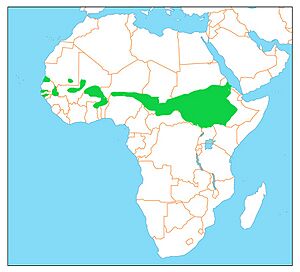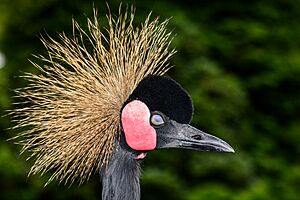Black crowned crane facts for kids
Quick facts for kids Black crowned crane |
|
|---|---|
 |
|
| Conservation status | |
| Scientific classification | |
| Genus: |
Balearica
|
| Species: |
pavonina
|
 |
|
| Synonyms | |
|
Ardea pavonina Linnaeus, 1758 |
|
The black crowned crane (Balearica pavonina) is a beautiful bird. It belongs to the crane family, Gruidae. This bird is famous for the golden, bristly crown on its head.
You can usually find black crowned cranes in wet areas. These are called wetlands. They live in parts of Africa south of the Sahara Desert. Wetlands are important for them to breed, find food, and rest. They also look for food in grasslands and near farms.
Contents
About the Black Crowned Crane
The black crowned crane is a type of bird called a crane. It is related to other cranes like the grey crowned crane. There are two main types, or subspecies, of the black crowned crane. They are called Balearica pavonina pavonina and Balearica pavonina ceciliae.
What They Look Like
Black crowned cranes can grow quite tall. They can be about 105 centimeters (41 inches) long. They weigh between 3 to 4 kilograms (6.6 to 8.8 pounds). Their wings can spread out to 180 to 200 centimeters (71 to 79 inches).
These birds are mostly dark grey or black. Their most special feature is the stiff, golden feathers on their head. These feathers form their unique crown. Each golden feather is like a tiny spiral. It is white on one side and brown on the other. The very tip is black.
They also have white feathers on the top part of their wings. Under their chin, they have a small red skin pouch. This is called a gular sac. Their long legs and toes are black. They have a long back toe that helps them hold onto tree branches.
Black crowned cranes also have red patches on their cheeks. These patches are just behind their eyes. The size of these red patches can be different. The West African black crowned crane has red on the lower half of its cheek. The Sudan black crowned crane has red that goes up higher. Male cranes are a bit bigger than females. But they look very much alike. Young cranes are mostly grey. They have a brown crown and neck.
Where They Live
Black crowned cranes live in open areas of Africa. These areas include grasslands and shallow wetlands. They also live near lakes and rivers. Sometimes, they rest in trees. Their home range stretches across many countries. It goes from West Africa to East Africa.
The Balearica pavonina pavonina subspecies lives in the western part of this area. The Balearica pavonina ceciliae subspecies lives in the east. Many of them are found in Sudan.
How They Behave
Their Sounds
Black crowned cranes make low, soft sounds. They often make a "honk" sound. They also make a "ka-wonk ka-wonk ka-wonk" sound.
What They Eat
Black crowned cranes eat many different things. They are not picky eaters. Their diet includes insects like grasshoppers and flies. They also eat other small creatures. These include snails, millipedes, and crabs. They will also eat fish, frogs, and small reptiles.
They usually stay in wetlands. But during the dry season, they might look for food elsewhere. They can be seen in short, dry grasses. They also look for food in areas where there are many insects. Sometimes, they eat crops from farms. These crops include rice, corn, and lentils. They usually peck food off surfaces. They might stomp their feet to make hidden insects come out of the soil.
How They Raise Their Young
Black crowned cranes breed at different times of the year. This depends on the wet and dry seasons. Breeding success relies on the environment being suitable. During the dry season, many cranes gather in large groups. These groups can have hundreds of birds. This happens before the next breeding season. Young cranes that are not yet old enough to breed (3–5 years old) join these groups.
During the breeding season, cranes are usually seen in pairs. But sometimes, they are in groups of up to 20 birds.
They build their nests in or near thick wetlands. Their nests are round platforms made of grasses. They can change where they nest. This depends on where they can find food and shelter. A female crane usually lays 1 to 3 eggs. Each egg weighs about 122 to 168 grams (4.3 to 5.9 ounces). Both parents take turns sitting on the eggs. This is called incubation. It lasts for 28 to 31 days.
Male cranes often stand guard near the nest. They might be in nearby trees. They are ready to warn of any danger. Female cranes look for food while the male guards. The day after hatching, the baby chicks look for food with their parents. They can fly when they are about 60 to 100 days old.
Protecting Black Crowned Cranes
The black crowned crane is a "Vulnerable" species. This means its population is at risk. There are about 28,000 to 47,000 of these birds left.
A big problem for them is the loss of wetlands. These wetlands are vital for their survival. They need them for breeding, feeding, and resting. But wetlands are being destroyed. This happens because of droughts. Also, wetlands are drained for farming. They are also used for building dams or irrigation projects. When wetlands are broken up, it's harder for animals to move around. This means less food for the cranes.
Hunting and capturing these birds also harms their populations. People sometimes trade them illegally.
In Culture
The black crowned crane is the national bird of Nigeria. It is often seen as a symbol of peace.
Gallery







